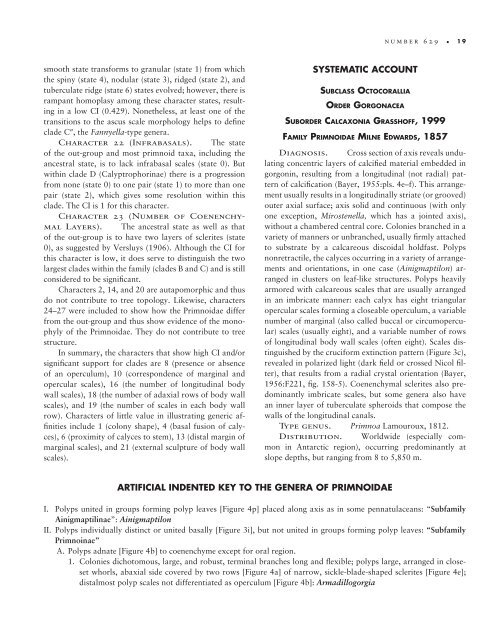A Generic Revision and Phylogenetic Analysis of the Primnoidae
A Generic Revision and Phylogenetic Analysis of the Primnoidae
A Generic Revision and Phylogenetic Analysis of the Primnoidae
Create successful ePaper yourself
Turn your PDF publications into a flip-book with our unique Google optimized e-Paper software.
smooth state transforms to granular (state 1) from which<br />
<strong>the</strong> spiny (state 4), nodular (state 3), ridged (state 2), <strong>and</strong><br />
tuberculate ridge (state 6) states evolved; however, <strong>the</strong>re is<br />
rampant homoplasy among <strong>the</strong>se character states, resulting<br />
in a low CI (0.429). None<strong>the</strong>less, at least one <strong>of</strong> <strong>the</strong><br />
transitions to <strong>the</strong> ascus scale morphology helps to defi ne<br />
clade C″, <strong>the</strong> Fannyella-type genera.<br />
Character 22 (Infrabasals). The state<br />
<strong>of</strong> <strong>the</strong> out-group <strong>and</strong> most primnoid taxa, including <strong>the</strong><br />
ancestral state, is to lack infrabasal scales (state 0). But<br />
within clade D (Calyptrophorinae) <strong>the</strong>re is a progression<br />
from none (state 0) to one pair (state 1) to more than one<br />
pair (state 2), which gives some resolution within this<br />
clade. The CI is 1 for this character.<br />
Character 23 (Number <strong>of</strong> Coenenchymal<br />
Layers). The ancestral state as well as that<br />
<strong>of</strong> <strong>the</strong> out-group is to have two layers <strong>of</strong> sclerites (state<br />
0), as suggested by Versluys (1906). Although <strong>the</strong> CI for<br />
this character is low, it does serve to distinguish <strong>the</strong> two<br />
largest clades within <strong>the</strong> family (clades B <strong>and</strong> C) <strong>and</strong> is still<br />
considered to be signifi cant.<br />
Characters 2, 14, <strong>and</strong> 20 are autapomorphic <strong>and</strong> thus<br />
do not contribute to tree topology. Likewise, characters<br />
24–27 were included to show how <strong>the</strong> <strong>Primnoidae</strong> differ<br />
from <strong>the</strong> out-group <strong>and</strong> thus show evidence <strong>of</strong> <strong>the</strong> monophyly<br />
<strong>of</strong> <strong>the</strong> <strong>Primnoidae</strong>. They do not contribute to tree<br />
structure.<br />
In summary, <strong>the</strong> characters that show high CI <strong>and</strong>/or<br />
signifi cant support for clades are 8 (presence or absence<br />
<strong>of</strong> an operculum), 10 (correspondence <strong>of</strong> marginal <strong>and</strong><br />
opercular scales), 16 (<strong>the</strong> number <strong>of</strong> longitudinal body<br />
wall scales), 18 (<strong>the</strong> number <strong>of</strong> adaxial rows <strong>of</strong> body wall<br />
scales), <strong>and</strong> 19 (<strong>the</strong> number <strong>of</strong> scales in each body wall<br />
row). Characters <strong>of</strong> little value in illustrating generic affi<br />
nities include 1 (colony shape), 4 (basal fusion <strong>of</strong> calyces),<br />
6 (proximity <strong>of</strong> calyces to stem), 13 (distal margin <strong>of</strong><br />
marginal scales), <strong>and</strong> 21 (external sculpture <strong>of</strong> body wall<br />
scales).<br />
SYSTEMATIC ACCOUNT<br />
SUBCLASS OCTOCORALLIA<br />
ORDER GORGONACEA<br />
number 629 19<br />
SUBORDER CALCAXONIA GRASSHOFF, 1999<br />
FAMILY PRIMNOIDAE MILNE EDWARDS, 1857<br />
Diagnosis. Cross section <strong>of</strong> axis reveals undulating<br />
concentric layers <strong>of</strong> calcifi ed material embedded in<br />
gorgonin, resulting from a longitudinal (not radial) pattern<br />
<strong>of</strong> calcifi cation (Bayer, 1955:pls. 4e–f). This arrangement<br />
usually results in a longitudinally striate (or grooved)<br />
outer axial surface; axis solid <strong>and</strong> continuous (with only<br />
one exception, Mirostenella, which has a jointed axis),<br />
without a chambered central core. Colonies branched in a<br />
variety <strong>of</strong> manners or unbranched, usually fi rmly attached<br />
to substrate by a calcareous discoidal holdfast. Polyps<br />
nonretractile, <strong>the</strong> calyces occurring in a variety <strong>of</strong> arrangements<br />
<strong>and</strong> orientations, in one case (Ainigmaptilon) arranged<br />
in clusters on leaf-like structures. Polyps heavily<br />
armored with calcareous scales that are usually arranged<br />
in an imbricate manner: each calyx has eight triangular<br />
opercular scales forming a closeable operculum, a variable<br />
number <strong>of</strong> marginal (also called buccal or circumopercular)<br />
scales (usually eight), <strong>and</strong> a variable number <strong>of</strong> rows<br />
<strong>of</strong> longitudinal body wall scales (<strong>of</strong>ten eight). Scales distinguished<br />
by <strong>the</strong> cruciform extinction pattern (Figure 3c),<br />
revealed in polarized light (dark fi eld or crossed Nicol fi lter),<br />
that results from a radial crystal orientation (Bayer,<br />
1956:F221, fi g. 158-5). Coenenchymal sclerites also predominantly<br />
imbricate scales, but some genera also have<br />
an inner layer <strong>of</strong> tuberculate spheroids that compose <strong>the</strong><br />
walls <strong>of</strong> <strong>the</strong> longitudinal canals.<br />
Type genus. Primnoa Lamouroux, 1812.<br />
Distribution. Worldwide (especially common<br />
in Antarctic region), occurring predominantly at<br />
slope depths, but ranging from 8 to 5,850 m.<br />
ARTIFICIAL INDENTED KEY TO THE GENERA OF PRIMNOIDAE<br />
I. Polyps united in groups forming polyp leaves [Figure 4p] placed along axis as in some pennatulaceans: “Subfamily<br />
Ainigmaptilinae”: Ainigmaptilon<br />
II. Polyps individually distinct or united basally [Figure 3i], but not united in groups forming polyp leaves: “Subfamily<br />
Primnoinae”<br />
A. Polyps adnate [Figure 4b] to coenenchyme except for oral region.<br />
1. Colonies dichotomous, large, <strong>and</strong> robust, terminal branches long <strong>and</strong> fl exible; polyps large, arranged in closeset<br />
whorls, abaxial side covered by two rows [Figure 4a] <strong>of</strong> narrow, sickle-blade-shaped sclerites [Figure 4e];<br />
distalmost polyp scales not differentiated as operculum [Figure 4b]: Armadillogorgia

















